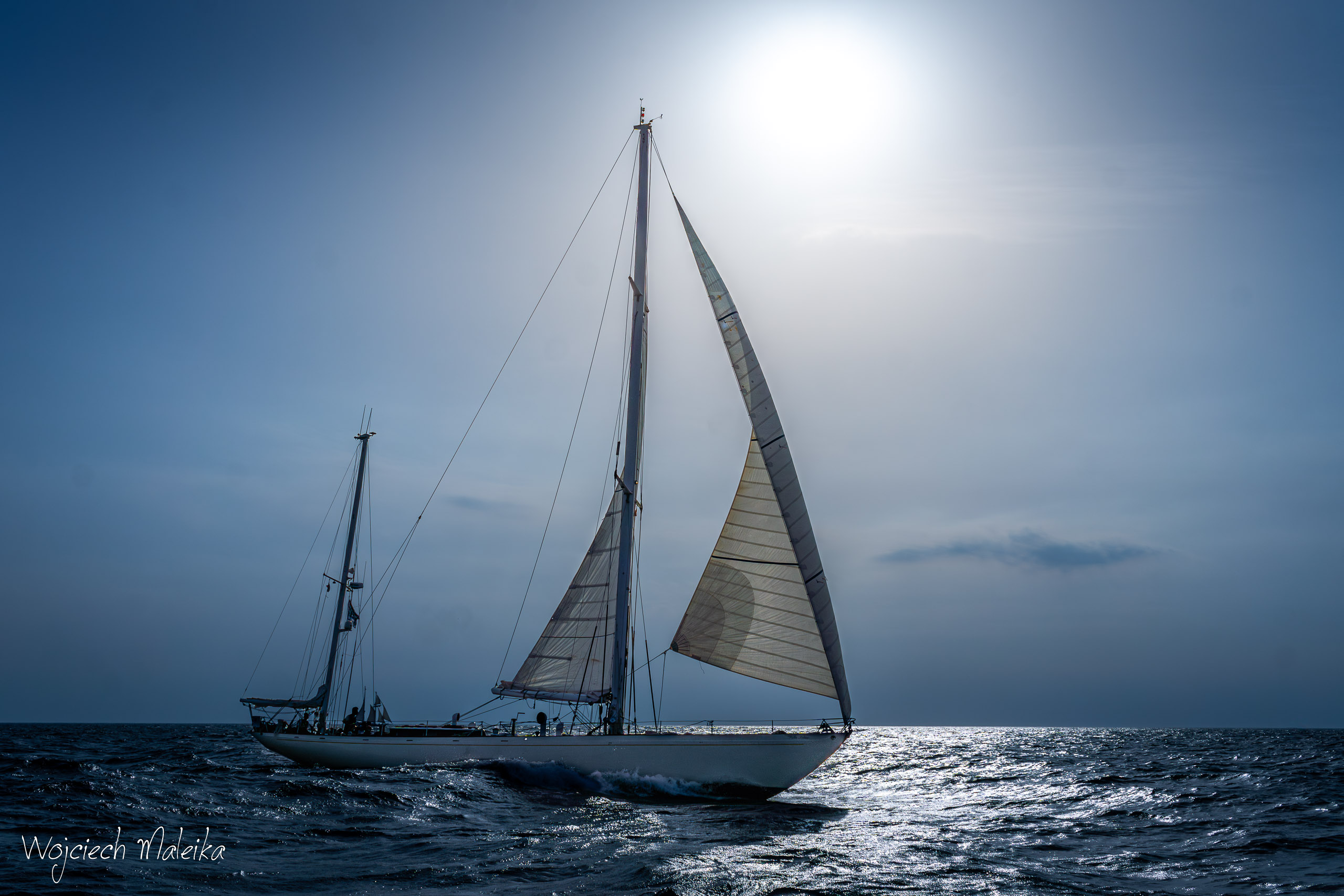News / Dar Szczecina – the fastest D-class yacht in the first TSR race!
It was a short but very demanding race – a real struggle in the wind and rain. The rally, with ships sailing their first race of this year’s The TallShipsRaces (TSR), started in Helsinki, and the fastest D-class yacht was our Dar Szczecina.
The section from Klaipeda to Helsinki, although it was quite short, proved very demanding. As the captain of the Dar Szczecin, Wojciech “Bolo” Maleika, told us, it was certainly not a boring race.
“The first stage of The TallShipsRaces has just ended. The crew of Dar Szczecina competed in D (spinnaker) class. The route of the race was almost 300 nautical miles long, and winds blowing from the stern or halfway along the side made us sail really fast. However, it was not a boring race. Strong wind gusts, a thunderstorm resulting in a 40-knot gale, and frequent changes in wind direction made the crew change sails as many as fifteen times. There was also a night of high-speed sail under the spinnaker and a constant battle with much newer and faster D-class vessels. In the end, although still unofficially, Dar Szczecina took the first place in its class, which brought a smile on its crew’s (and the captain’s, too) faces”, added “Bolo”.
The fastest sailing ship of the first race was Frederic Chopin. Our second crew on Zryw arrived at the finish line a little later, taking the fifth place in its class.
“The start went super cool, in the initial phase of the race we sailed at a maximum speed of 10.01 knots. Then, a storm began and all the vessels had to slow down. It was the first time the crew had seen a storm at sea and it will probably stay with them for the rest of their lives, but the mood was good both during the storm and for the rest of the race. During the whole race, there were a lot of sail changes, much practice on how to steer upwind and opportunities to gain racing knowledge. At the finish line, we were unofficially fifth in class, having defeated a lot of very fast yachts, including Tornado which sails comparably to Dar Szczecina. Currently, the crew is preparing for tomorrow’s crew parade and crew party”, said Jędrzej Owczarski, Zryw’s captain.
The official results and the award ceremony are yet to come. The crews now have a few days of rest and good fun. The vessels will then take part in a friendship cruise to Tallinn, from where they will embark on a second race to Turku.
________________________________________________________
From the ship's log
Below is Captain Wojciech Maleika’s comprehensive account of the first stage of The TallShipsRaces.
The start of the first race took place in windy conditions, near Klaipeda – the port where this year’s sailing event began. As the wind was blowing hard enough, we decided not to start with the spinnaker up, as we knew it would be more useful for the rest of the race. The crew of the Dutch yacht, Urania, tried to put theirs up but it ended up tearing into pieces.
Right after the start line, we were probably the second vessel among class-C and class-D ships, speeding at full sail above 9 knots. Right behind us were our competitors – fast and newer boats with super racing sails. We knew already then that it would not be plain sailing and that calm sailing on a safe set of sails would certainly not yield us a good result. That’s why, right from the start, we would change sails every now and then, adjusting their optimal set. We were constantly seeking the most optimal trim depending on wind direction and strength. We were keeping right behind Frederic Chopin and Dar Młodzieży – these two were speeding in the lead under full sail.
In the evening, we were hit by a storm with a strong gale. Fortunately, we had seen it clearly on the radar and reduced the sails just on time, reefing the mainsail as much as 3 reefs and putting down the genoa. Forty knots straight astern, we accelerated to over ten knots, with heavy rain seeping into every nook and cranny, including our clothes. Fortunately the storm was short and, after a while, we could put up a large set of sails which made us sail fast again. That was not when we put up the spinnaker (although we would like to). The wind was still too strong and this was the first time we had enrolled in the class-D (spinnaker) regatta.
At 9.30 p.m., the spinnaker was finally up. To make it more durable, we had added several lines – barber haulers, topping lifts, boom vangs, braces and sheets. In the cockpit, there was quite a tangle. The spinnaker fired right up, pulling us firmly forward. Our speed quite often exceeded the dazzling 10 knots, but steering was not easy at all. Strong waves would take over the stern every now and then, trying to twist the entire yacht sideways. We turned the rudder wheel much so that our course line would come out as straight ahead as possible.
After a couple of hours I realised that I had less and less control of the yacht. It was simply blowing too hard and the waves were too steep. I was afraid I might end up with an uncontrollable capsize. We put down the spinnaker quite efficiently, without any unnecessary episodes. Then, we put up the genoa instead, sharpening up a little to retain as much speed as possible.
In the morning, we reached the first waypoint – a virtual point on the sea that we had to pass. The next stretch seemed rather easy, with the wind mainly blowing from the side but with changing strength and direction. This gave the crew no time to relax. Sail changes seemed to be needed every hour, requiring plenty of work to do, with an increasingly raging deck.
As we reached the second waypoint in the afternoon, the wind had gradually quietened. I thought to myself, when if not now? The spinnaker went up. We were first to put it up among several yachts sailing past us at this stage of the race, right in the lead. Fortunately, we managed to tame both the sail and the vessel, without much listing or uncontrollable spurting. We also managed to gradually catch up with our competitors, Lietuva and Theia, fast yachts with slightly better conversion rates. More importantly, we moved much ahead of Stella Polare and Linda, which would outperform us. We realized that the contest was tight and minutes seemed to be passing in a flash of time over the 300-mile route that we had to cover.
The last hours meant sailing in full wind, not at all easy, requiring the searching for the optimum angle to the wind and constantly looking for speed. Every now and then, we would also check the position of the other yachts in our class, hoping to see if we stood a chance to win against them. We finally arrived at the finish line at 3.00 am, with the beautiful colours of the sun rising on our port side. It could hardly look more fabulous. Instead of a bottle of champagne, we opened a box of chocolate-covered marshmallows, mindful of our likely success. We wouldn’t get the final results until we got to the harbour, but the odds were that we had won the D-class race for modern yachts with spinnakers – a class for professionals, fast yachts, those sailing at the top. And we were in the lead, which made us very happy.
In the class of sailing ships, without class division, Frederic Chopin won, followed closely by the large Finnish yacht Helena and the largest sailing ship of the Republic of Poland, Dar Młodzieży (as the commander himself calls it).
It may not have been a crazy or difficult race, but it was certainly a demanding one. Wanting to cut every mile or minute, we had to juggle the sails, adjust courses instantly, look for speed, and watch out for the competition. We ended up with fifteen sail alerts – quite a lot for a day and a half of sailing. It was all worth it. The sense of satisfaction in the crew was great, as were the smiles on their faces. With endorphins continuing to buzz, no one could fall asleep until morning. We’re already looking forward to Helsinki, which we’re heading to in the white night. A beautiful idea...



















